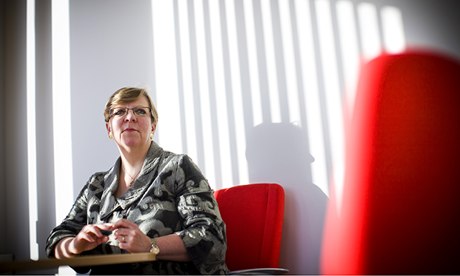 Parul Thapa, Apne AapRuchira Gupta, left and Gloria Steinem at a book store in New Delhi.
Parul Thapa, Apne AapRuchira Gupta, left and Gloria Steinem at a book store in New Delhi.
MS. GUPTA : Walking through the red-light areas of Sonagachi or lobbying in Albany for the New York State laws against human trafficking, Gloria and my life have interwoven into shared writing sessions, rallies, meetings, dinners, books, conversations, late night phone calls across continents, brainstorming and sometimes movies. With her, I have experienced how movements move and how immense the feminist movement is.
I was excited about the new wave of feminism that hit the streets after the December 2012 gang rape in Delhi. I wanted Gloria to see how the movement was really moving in India, and to share Gloria’s courage and hope with my fellow protesters.
So armed with a new collection of her essays that I edited, “As if Women Matter: The Essential Gloria Steinem,” I set up a road trip with Gloria from Delhi to Jaipur to Patna to Kolkata to Forbesgunge – the last being a small village on the Indo-Nepal border where poverty has created intergenerational prostitution — and finally Cochin in Kerala.
This journey’s goals are meeting old and new feminists, speaking at rallies, organizing with students, sitting in circles with women and girls trapped in prostitution, sharing ideas with writers, poets, journalists and thought leaders at the Jaipur Literary Festival and the Kolkata Literary Meet and going on a girl-led journey inside a red-light district. Follow our travels here on India Ink and see how big a family the global feminist movement has become.
MS. STEINEM, FROM NEW DELHI
Jan. 11, Saturday: The airport is calm and glamorous, but the roads on the way to Ruchira’s apartment are chaos. There are bicycle rickshaws, ancient black-and-yellow taxis darting about like bumble bees, buses overstuffed with passengers and trucks covered with folk art that could be in a museum. Even the occasional cow munches at the edge of traffic.
All this I remember from the two years I lived here as a student more than four decades ago, yet every visit since then, there have been more luxury cars, sleek motorcycles and giant billboards advertising everything from the newest computers to the tallest apartment buildings.
This is the secret of India. It adds, yet it never subtracts. Nothing should work – yet it does.
When I arrive at the garden apartment of my friend Ruchira Gupta, she gives me our schedule for the next couple of weeks. It, too, is a combination of old and new. An accomplished journalist reporting on women and girls taken from poor villages into big city brothels, she could no longer write about human trafficking without doing something about it. She started Apne Aap — which means Self-Empowerment – as a center of support for women and children trying to escape brothels, and find acceptance and schools for their children.
Now 10 years later, Apne Aap has centers in New Delhi, Kolkata, Mumbai and Forbesgunge, a town in Bihar, India’s poorest state. Now that there are more people in sex and labor slavery in the world than there were slaves in centuries past when it was legal – now due to big profits, easy transport and lax law enforcement — Apne Aap has become a beacon for other countries, too. That’s how we met, began working and writing together, and became friends who work together in both our countries.
As a great organizer, Ruchira initiates many projects — and on this trip, I am one of them. After the December 2012 gang rape and murder in New Delhi that sent thousands of protesters into the streets, Ruchira selected some of my activist essays that she thought could be useful here, introduced each of them with the reasons why and put them in a book. That’s why we’ve been invited to campuses and literary festivals in India.
For pure pleasure, we’ll also be re-visiting the waterways and peridot green fields of Kerala — the part of India I’ve always loved the most.
This trip is a full circle for me. India taught me how to organize from the bottom up when I came here only a decade after independence and walked through villages with the land reform movement. It changed my view of the world. Now that social justice movements must be as global as the vast inequalities we are trying to change, Ruchira and I and many others are working together.
As if in proof, Vandana Shiva drops in for tea a few minutes after I arrive. She is a writer, environmental activist, physicist and eco-feminist of global influence, yet this is the first chance we’ve had to talk. She is warm, friendly, and has the mark of the truly intelligent: You can understand every word she says.
Today, she is bringing news of another genetically modified seed scandal. Like the expensive cottonseed from Monsanto that promised immunity from pests and weeds – yet produced super pests, super weeds and such high costs that many Indian farmers suffered financial disaster and at least 75,000 farmers committed suicide — a genetically modified banana is about to be pushed by global interests. They promise that if you buy this seed that will replace India’s 200 varieties of homegrown bananas, it will supply more iron to pregnant women. Of course, its iron content is less than that in turmeric, a common Indian spice.
In movements, you need a sense of humor. We consider making a T-shirt:Don’t Go Bananas. Trust Nature.
 Parul Thapa, Apne AapGloria Steinem sitting with children at the Apne Aap office in New Delhi.
Parul Thapa, Apne AapGloria Steinem sitting with children at the Apne Aap office in New Delhi.
Jan. 13, Monday: In the airy, simple offices of Apne Aap, I sit cross-legged in a circle with 10 teenage girls. They are the daughters of families who belong to a tribe that was nomadic for centuries, and resisted all British efforts to turn them into wage slaves. When their traditional life outlawed, the men became petty thieves, and their wives and daughters were prostituted. In the terms of the British, they became “criminal tribes.”
That label was removed with Independence, but they still had no other way to survive. Even many Indians of goodwill had come to believe they were incapable of change. Now, Apne Aap has set out to prove this untrue, one girl and one family at a time, by providing schools, respect, encouragement.
I know all this, but the sight of these fresh-faced, shy, spirited girls has driven it out of my head. They could be from anywhere. One asks how I became a writer, which is what she wants to do. Another wants to be a dancer. Others say they hope to become teachers or health professionals.
I ask what one thing would help each of them right now – the next day and the next. Most say education. Then one is silent. Finally, she says: “the truth.”
I realize that her parents are likely to marry her off to a man from the tribe who will become her pimp. If she goes to school, she will have to overcome guilt at earning no money for her husband and family.
I don’t know how she will deal with the truth – but she wants to know.
Jan. 15, Wednesday: At our formal book launch at the India International Center, I’m suddenly aware that my 22-year-old self once came to there. The auditorium is overflowing with old and young feminists, plus the curious.
On stage, Devaki Jain, the Gandhian feminist economist who is my oldest friend in the world, calls me “truthful and courageous, transparent, brave and daring.” My younger and uncertain self wouldn’t be able to imagine or believe this. Then Ela Bhatt, founder of S.E.W.A., the Self Employed Women’s Association, which is the largest women’s union in the world, gives a rare and historic speech about her feminist journey and life’s philosophy. She should have received a Nobel Prize decades ago.
When I first met Ela, she was alone in believing that the poorest women in India could organize together and advance together. Illiterate and with no employer, they were the women who sold single cigarettes in the street, or straightened out nails and old pots and pans to resell them, or bought vegetables with a high-interest daily loan from a money changer, then tried to sell them in the street. Ela started by creating street nurseries for their children, then small credit groups for their businesses. Later, an economist named Muhammad Yunus would win a Nobel Prize for an imperfect version of this.
In the meanwhile, S.E.W.A. has reached a membership of 1.9 million women in India alone, and has spread to other countries in South Asia and Africa, plus Turkey and Russia.
On the stage with Ela, Devaki and Ruchira, I feel a pleasure so profound that I don’t know how to express it. But at least I can explain to this audience that Ruchira has become that rare activist who is at home in the streets, her own Parliament, Washington and the United Nations, and so is uniquely effective in all three. She is a living bridge between the truth at the bottom and the power at the top.
At the reception afterward, Ruchira, who is some 30 years younger than me and my two friends, tells me that she feels nurtured, protected and inspired by us. That is reward enough.
Jan. 16, Thursday: In Connaught Place, we as students once escaped to sophisticated and forbidden coffee shops. Now, its curved promenade of shops is old-fashioned next to luxurious hotels and modern office buildings.
But inside a two-story store in that arcade, the women of S.E.W.A. sell beautiful clothes and weavings of their own making. Upstairs today, there are 30 of so S.E.W.A. women who have gathered to meet with us — Ruchira, me, Devaki and several women from Apne Aap – for the first time. We are welcomed with tea, homemade sweets and a song about their movement.
I am sitting next to a woman who is the elected president of this huge union. Many women speak about their diverse work, and Ela is a presence but doesn’t direct. In the way of a rare and great leader, she knows how to pass along power.
We learn about S.E.W.A.’s small farmers who have organized successfully to keep their land away from agribusiness, but the products in this store are also threatened by Wal-Mart’s cheaper and less durable ones made in Chinese sweatshops. Women also tell their personal stories of gaining safety and independence. Apne Aap women speak about their organizing, too.
I wonder if the S.E.W.A. women will understand these activists who have been rendered less respectable by being prostituted. Ela Bhatt asks if they can tell their families what they do, and one explains that it was her husband who pimped her.
I can feel surprise – and then understanding. I realize that these two groups can organize together. Later, Ruchira tells me she realized this at the same time.
At the end of our meeting, the S.E.W.A. women sing one last song. It is “We Shall Overcome” – in Gujarati.
In organizing, I’ve always used a tree as a symbol of the fact that lasting change grows from the bottom. After today, I will say this is a banyan tree whose branches dip down in dry weather, take root, grow up again and create a forest from one trunk. Globally, we have to become a banyan tree.
Next stop: Jaipur Literature Festival







